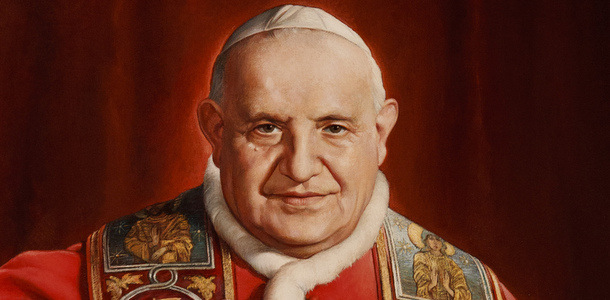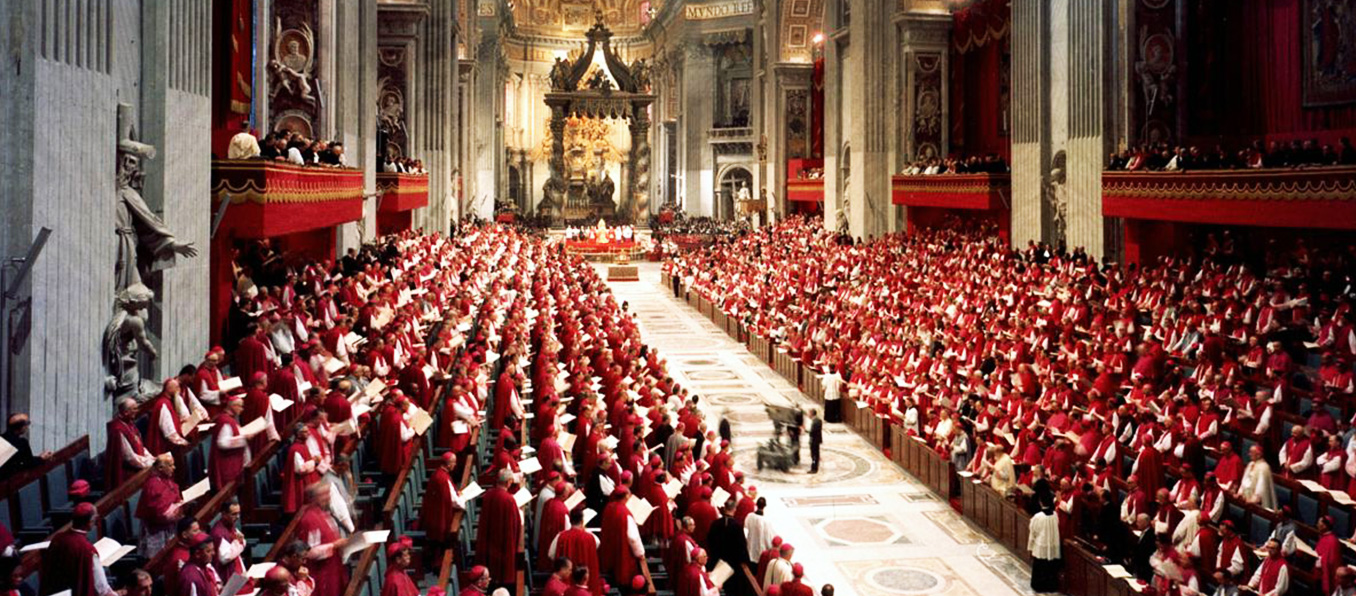The Canadian Reception of Vatican II
WYH3271HS Winter 2017 January 12, 2017
Links
St. Michael's College is a centre for the study of Vatican II. A page on its website summarizes its interests, approaches, and research resources.
Here's the website for the Dominican Institute for Research on Vatican II in Canada.
The second Vatican Council
In 1959, soon after becoming Pope, John XXIII announced his intention to call an ecumenical council. Vatican II met from 1962 to 1965, in four working sessions. As many as 2300 bishops from around the world participated. There were also numerous periti or experts, up to a hundred ecumenical observers, and 23 woman auditors.
Vatican II was to effect an aggiornamento (updating) in the life of the Church. Pope John XXIII spoke of opening the windows of the Church and letting in fresh air. A particularly important principle that freed the Council to act in this way was a distinction that the Pope made at the opening session, in a declaration called Gaudet mater ecclesia: 
"The deposit of faith, or truths which are contained in our time-honored teaching, is one thing; the manner in which these truths are set forth (with their meaning preserved intact) is something else."
This suggested that liturgical formulas, doctrinal propositions, theological methods, and other culturally conditioned forms were all open to discussion, as long as the substance of faith was honoured.
In a preparatory period, working drafts or schemata were written by commissions, but when they were presented to the Council, they were seen as excessively scholastic and condemnatory in their tone, and were rejected. New drafts were developed and debated. By the end of the Council, sixteen documents had been produced: four "constitutions" (the most important category), three "declarations", and nine "decrees". Their general aim was to represent a consensus, which was challenging given the spectrum of opinion among the bishops.
Important results included:
- A very high valuation of Scripture, interpreted according to modern critical standards, and available to the laity in vernacular translations;
- A commitment to lay participation in the liturgy, and in the wider life of the Church (a 'lay apostolate');
- An understanding of the Eucharist free of scholastic categories (like transubstantiation) centred on the presentation of the paschal mystery;
- The affirmation that the Church of Christ 'subsists in' the Roman Catholic Church, and that all other churches are in some greater or lesser measure defective;
- A commitment to holiness as the first pastoral priority of the Church;
- Commendation of ecumenical dialogue with the 'separated' families of churches.
Reception
The teachings of the Council are understood as subject to ‘reception’ by the faithful. According to the International Theological Commission, in a document of 2014 authorized for publication by the Prefect of the Congregation for the Doctrine of the Faith, ‘reception’ may be described as
a process by which, guided by the Spirit, the people of God recognizes intuitions or insights and integrates them into the patterns and structures of its life and worship, accepting a new witness to the truth and corresponding forms of its expression, because it perceives them to be in accord with the apostolic Tradition.
 'Reception' is connected with an understanding of the 'sensus fidelium,' or the understanding of the faithful. According to Lumen Gentium (12), "the entire body of the faithful, anointed as they are by the Holy One, cannot err in matters of belief.” The implication appears to be that any errors in conciliar teaching will drop out of the life of the Church. Vatican II thus rejected the separation between an active hierarchy and a passive laity, between the ecclesia docens (teaching church) and the ecclesia discens (learning church).
'Reception' is connected with an understanding of the 'sensus fidelium,' or the understanding of the faithful. According to Lumen Gentium (12), "the entire body of the faithful, anointed as they are by the Holy One, cannot err in matters of belief.” The implication appears to be that any errors in conciliar teaching will drop out of the life of the Church. Vatican II thus rejected the separation between an active hierarchy and a passive laity, between the ecclesia docens (teaching church) and the ecclesia discens (learning church).
The principle of reception is connected with the idea that ’Tradition' (often with a capital T) is a living reality. It's not that the present generation hands on to the next generation a set of words or some memorizable propositions from the previous generation. Rather, the living Tradition will change in formal ways, according to changing circumstnaces, and will be inculturated differently in different situations. Thus, the mass will always have the same authority, purpose, and sacramental substance, but it will be said and sung in different languages, in different ways, in different places around the world.
Thus, the teachings of the Council will be ‘received’ over the course of many years through a disciplined process of change in the devotional, pastoral, and catechetical practices of the faithful.
Moreover, the teachings of the Council need to be interpreted. Disagreements can and do arise about the documents of the Council. For instance, some texts are intentionally a little ambiguous in places in order to cover a legitimate spectrum of theological opinion among the Council Fathers. Study, discussion, and authoritative clarification of the Council texts are part of the process of reception.
Canada and Vatican II
Canadian bishops played a significant role in the Council. Cardinal Leger of Montreal served on the central preparatory commission, and was painfully aware that its reactionary approach was unacceptable. His "supplique" or petition to the Pope was favourably received, and paved the way for the rejection of the preparatory drafts and an invitation for more progressive efforts. Maxim Hermaniuk of Winnipeg, the chair of the Ukrainian Catholic delegation, was a prominent voice for conciliarity. Gregory Baum of St. Michael's College drafted a document that evolved into Nostra aetate, which re-set relationships between the Church and the Jewish world. Archbishop Philip Pocock of Toronto helped revive the permanent diaconate in the Roman Catholic Church, inspired by the teaching of Vatican II. Bishop Alexander Carter of Sault Ste-Marie picked up on the Council's teaching on the important role of the laity, and created lay service associations in his diocese. He permitted women and native elders to preside at communion services when priests weren't available. A story in the Catholic Register of Toronto by Michael Swan gives details.
The "reception" of Vatican II in Canada in the liturgy, teaching, and pastoral practice of the Roman Catholic Church, and its influence on other denominations, is studied in Michael Attridge, Catherine Clifford, Gilles Routhier, Vatican II: Expériences canadiennes, Canadian Experiences, University of Ottawa Press, 2011.